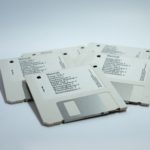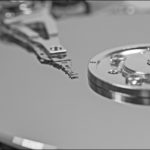A number of QNAP NAS boxes, including the TS-253B, TS-253D (that I use), and the TS-453KX recently reviewed here sport full-on PCIe slots. You can use these to add features not present in box as sold: primarily 10GbE and M.2 slots for SSDs. The cards, including the QM2-2P10G1TA that QNAP sent me, aren’t cheap, but they do offer a marvelous improvement in performance.
The QM2-2P10G1TA I tested has three different brackets: flat, low-profile for use in a NAS box, plus two angular types for low-profile and regular profile PCIe slots in normal computers. Yes, this card will work in any expandable PC, however, being only PCIe 2.0 x4, it’s a bit behind the times for that use. For NAS communicating over Ethernet, it’s more than fast enough.

Installing the QM2-2P10G1TA into the TS-253B that I used for testing required removing the box’s cover, removing a dummy bracket (one screw), swapping the correct bracket onto the card (two screws), inserting the card into the PCIe slot and securing it (one screw), then reinstalling the cover (two screws). Total time, about five minutes. Add five minutes for installing the two NVMe SSDs onto the card.
QNAP’s software setup for the caching SSDs on the card is a bit more versatile than what I’ve seen from Synology and ASUSTOR recently. You may actually use the NVMe SSDs on the QM2-2P10G1TA as stand-alone volumes. Sweet.
USB Adapter
PCIe adapters aren’t the only way to update a QNAP box. The company also sells its QNA-UC5G1T 5Gbps Ethernet for $79. Though it’s not particularly fast to initialize (give it a couple of minutes and don’t report it as non-operational as I did.), it delivers about 2.5 times the throughput of gigabit.
I did experience one glitch with the QNA-UC5G1T: write speeds were about 25% of what they should’ve been when I used it in conjunction with the Ipolex 10GbE SFP+ to RJ45 adapter I used on the switch end of the connection. Where the issue lay, I was never able to ascertain as both pieces of hardware worked fine with other equipment. Go figure.
Note that you might be able to find Linux drivers for other, cheaper, $35 2.5GbE USB adapters. I have installed these with Synology boxes, but not QNAP. Check the forums.
Performance
I ran tests on the TS-253B/QM2-2P10G1T combo with bare HDDs, HDDs with the NVMe caching enabled (two WD Black NVMe 1TB SSDs in RAID 0), and an NVMe volume with one WD Black. I repeated the tests with gigabit, 5GbE, and 10GbE. How much of a performance boost do you get for your $79 or $249 (plus the cost of SSDs)? Quite a bit.

The results above show just how dependent NAS performance is on the type of Ethernet in use. Gigabit caps sustained throughput at around 120MBps no matter what the media inside the box. 5GbE more than doubled sustained throughput in all three tests and allowed the NVMe drive to breath better when on its own. 10GbE also showed great improvement in terms of sustained throughput. Note that NAS Tester 1.7, a handy utility that does simple copy operations and times them, functions via SMB.
CrystalDiskMark 7 refused to return what I consider logical results, claiming almost the same results from an un-cached hard drive as from the NVMe drive. I switched to AS SSD using iSCSI targets and got some legit feedback on small file writes. You can see these below.

You will get better random read/write results when NMVe caching is in play. However, it doesn’t kick in until the primary DRAM cache is exhausted. The TS-253B used for these tests had 4GB of system memory, so the NMVe cache likely didn’t kick in until the 2GB-3GB mark of the 10GB AS SSD tests.
Note that all this performance does come at a price. The formerly cool as a cucumber TS-253B was considerably warmer with the QM2-2P10G1TA installed. This despite the noisy fan on the card spinning constantly. I’m assuming the majority of the heat is from the 10GbE which runs far hotter than gigabit.
A New Life
If you want to give your older PCIe equipped QNAP box a new lease on life, I highly recommend the QM2-2P10G1TA with NVMe caching. I’m sure you can do just as well with much smaller and/or slower NVMe SSDs as Ethernet, even 10GbE is always a limiting factor.
If you’re looking for a lesser, but still impressive performance upgrade for a lot less money, the 5GbE adapter with more memory will deliver it (check your box’s specs). Additionally, if you want 10GbE without NVMe, QNAP sells the QXG-10G1T single port PCIe adapter for $139. This can be handy if you’re already running SATA SSDs in the main bays.










